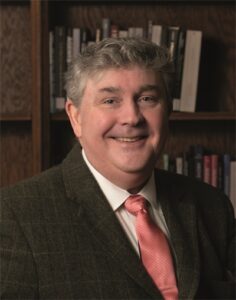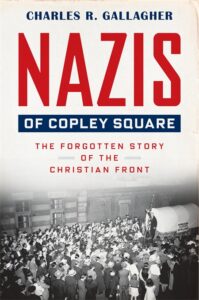
The Nazis of Copley Square: the Forgotten Story of the Christian Front
 Spycraft. Nazis. The Vatican.
Spycraft. Nazis. The Vatican.
In his latest book, Vatican diplomacy expert Rev. Charles R. Gallagher, S.J. casts his glance stateside and takes an in-depth look at terrorism, Catholic theology and the mysterious world of espionage during World War II.
In “The Nazis of Copley Square: The Forgotten History of the Christian Front,” Fr. Gallagher spotlights a forgotten history of the American far right by detailing, through previously classified FBI documents, a clandestine plan by Catholic extremists to overthrow the U.S. government.
An expert on Catholicism, diplomacy and international relations, Fr. Gallagher examines the role of the U.S. counterintelligence and the Catholic Church prior to and during World War II to stop the rise of the Christian Front, a paramilitary group of lay Catholics who viewed themselves as crusaders fighting against Communism for the spiritual purification of the nation. Inspired by Nazism and guided by their religious beliefs, the Christian Front sought to incite a revolution and install a temporary dictatorship in the U.S.
Released on September 28, 2021, Nazis of Copley Square is available from Harvard University Press.
IACS spoke to Fr. Gallagher about his new book.
 IACS: How did you find the topic and why did you write this book?
IACS: How did you find the topic and why did you write this book?
Fr. Gallagher: When I was a sophomore in college I took a class on U.S. national security history and my professor was a historian of the FBI. During my research for the class, I found newspaper coverage of a group of Catholics who tried to overthrow the government in 1940. I had never heard of Catholics trying to overthrow any government, let alone the U.S. government. Growing up, I had always been taught to be a patriotic Catholic.
At the time, I wanted to write a paper on this group of “fringe crazies.” But my professor said I couldn’t, simply because there wasn’t anything to write about. He was right — at least, that was the perception for 70 years among historians. The case brought by the U.S. government against the group, called the Christian Front, had faltered, and then World War II arrived. As the larger scope of the war consumed news headlines, everyone forgot about the Christian Front.
When working toward my doctorate at Marquette University, my dissertation was a biography on the first American to be named a diplomat at the Vatican. In the diplomat’s diary, he mentions this group.
The Vatican hierarchy — and even the Pope himself — was concerned about this issue and taking it seriously. They saw the rise of the Christian Front as something that needed to be examined and figured out. That’s when I knew I needed to investigate further.
What challenges did you face when researching and writing?
Fr. Gallagher: I like using intelligence documents to write church history — to see what those agencies are writing about religious actors and religious institutions. Getting these documents declassified is the first thing I have to do. Writing the “Nazis of Copley Square” required getting 4,200 pages of documents declassified by the FBI — a process that stretched six years, requiring a lot of patience and persistence. In the background, I was doing extra research, snooping around and trying to find scraps of documents with information. I consulted between 50 to 60 archives. It takes a lot of time – but the benefit is that you’re the first person seeing this declassified material. I had a jaw dropping moment in just about every chapter I wrote.
Where did the name of the book come from?
Fr. Gallagher: The Christian Front’s headquarters were located at the Copley Square Hotel in downtown Boston, and the organization’s leader was in direct secret meetings with a Nazi SS officer.
Why did it happen in Boston? The city has an interesting history with religious, racial and ethnic tension.
Fr. Gallagher: The Christian Front flourished in Boston because it positioned itself as an organization of lay working class Catholic intellectuals. Boston is unique because of its heightened sense of intellectual fervor, along with the intellectual marketplace happening in the city. The Christian Front was deeply theological in their political organization and political positions. But they were also deeply antisemitic, and their anti-Semitism was religiously rooted in the theology of the day. That’s the sad part of this book — these people were theologically astute and inquisitive, and they applied anti-Semitism in a way that paralleled Nazis, while still being able to call themselves authentically Catholic.
After World War II, the Church began reforming itself, leading to the Second Vatican Council, and a formal condemnation of anti-Semitism.
How did the rise of the Christian Front happen?
Fr. Gallagher: When I approached my editors at Harvard with the book idea, I told them I was researching three different spy rings involving Catholics in Boston. But I wasn’t writing a spy story. Rather, it was a story about religion and theology. One of the Christian Front’s theological impulses I identified in my research was the Mystical Body of Christ, which was dominant in the 1930s – the way that climate change, Laudato si’ and ecological stewardship dominates the Catholic theological discourse today. Mystical Body of Christ theology was transnational, Christo-centric and broke down borders spiritually. When Catholics were persecuted by Communists in one part of the world, Church members across the globe could identify with that pain. The fire-bombing of churches in Barcelona had impact – through Christ’s mystical body – in Boston.
The other pillar of theology that supported the group’s ascendancy was what was then known as Catholic Action. Sponsored by Pope Pius XI in 1922, it was meant to be a global program designed to promote social justice at the parish level, organized by priests and conducted by lay people. Due to Communist persecutions of Catholics in Mexico and Spain, anti-Communism became an unofficial theme of Catholic Action. The Christian Front was led by devout lay Catholics who were supported by several priests. Because they had clergy support, the Christian Front could legitimately claim they were doing “Catholic Action.”
How close did they get to achieving their goal?
Fr. Gallagher: I show in the book how the Christian Front was a serious national security threat from two perspectives: propaganda and paramilitary. It’s a difficult question to answer, because the answer lies within these classified documents – the government didn’t want to tell us how successful they were in their espionage and how close the Christian Front was to reaching their goals. But the fact is that the government viewed them as a serious threat to national security.
What lessons can we learn from the rise of the Christian Front?
Fr. Gallagher: Catholic leadership needs to pay attention to the fringe in order to govern effectively. The proclivity of an institution is to dismiss the fringe as inconsequential, but I think it’s more important for Catholic leaders, rather than dismiss the fringe within the church, to try to come to an understanding on what their motivations and their grievances are so they can be effectively addressed.
Did the Christian Front have a lasting impact on western Catholicism?
Fr. Gallagher: They became a link in the chain of what is far-right extremism today. They became progenitors of many of the impulses still present – they kept breathing above water with many of these ideas embraced by the American far-right. In doing so, the Christian Front allowed these ideas to maintain life on the political spectrum. Their ideas informed the anti-Semitic Christian Nationalism of the 1950s, the American Nazi Party of the 1960s, the Christian Identity Movement of the 1990s and impulses found in some areas of the far-right today.
Editor’s Note: Charles R. Gallagher is an associate professor of History at Boston College. His book “Vatican Secret Diplomacy” won the John Gilmary Shea Prize from the American Catholic Historical Association.